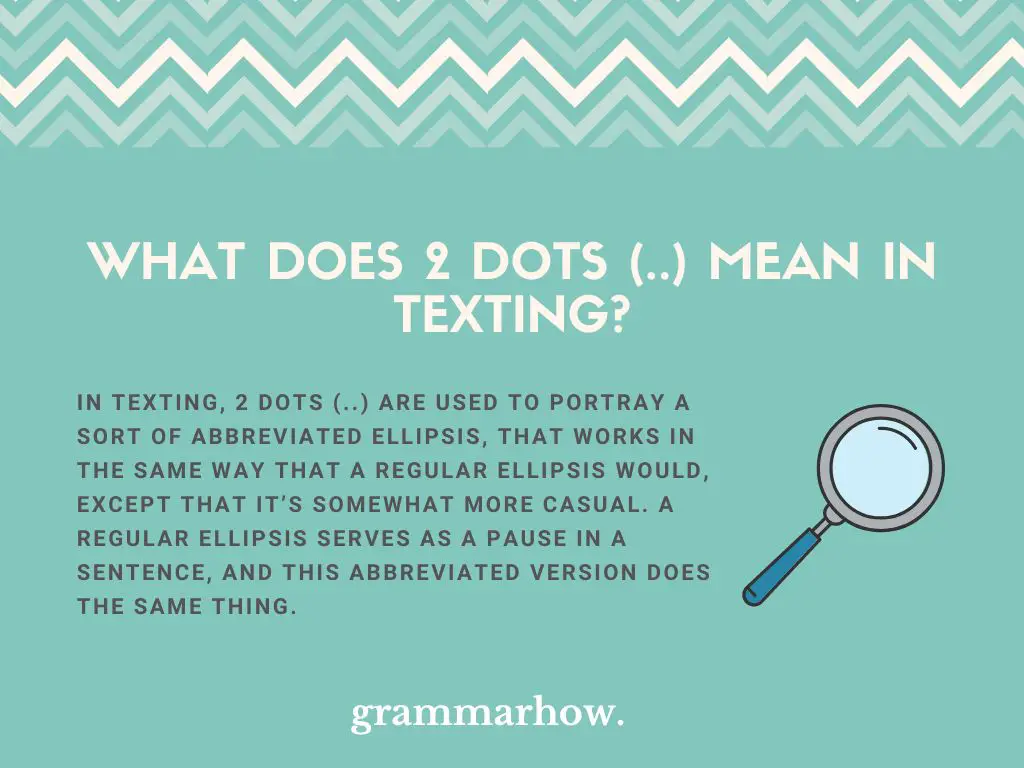Communications in the modern world have advanced a lot. There are plenty of innovative new ways to communicate that you might not be sure how to use. What do two dots (..) mean when used in texting? This article will clearly answer this question so that you know the answer.
What Does 2 Dots (..) Mean in Texting?
In texting, 2 dots (..) are used to portray a sort of abbreviated ellipsis. It works in the same way that a regular ellipsis would, except that it’s somewhat more casual. A regular ellipsis serves as a pause in a sentence, and this abbreviated version does the same thing.

Because texting is usually a fairly casual means of communication, many people have started using this ellipsis that only uses two dots instead of the standard three, so that it’s a less dramatic option.
Examples of Using Two Dots in a Sentences
Obviously, a new construction such as this new alternative ellipsis that only uses 2 dots has to be seen in action to actually be understood.
Here are some examples of conversations that, in some way, incorporate the two dots, so that you can see how they work:
- John: I was wondering.. Will you be doing anything after the meeting today?
- Mary: You know.. I don’t think that I’ll be busy after the meeting, no.
- Michael: Hey man uh.. Have you managed to check the files I sent you the other day?
- James: Hmm.. No I don’t think I’ve checked them yet, is it urgent?
- Jane: I’ve been looking over our numbers for this period.. There is very exciting news coming.
- Jimmy: Huh.. For some reason I didn’t expect this period’s numbers to be very good.
When Can I Use 2 Periods in Texting?
You can easily use 2 periods or two dots in texting whenever you want to create the impression of a brief pause that is shorter than a regular period and shorter than a regular ellipsis. It’s a really useful tool to be used in conversational environments.
Because the usage of two periods to create a sort of mini-ellipsis is relatively new, it’s not exactly widespread. This means that there is a limited list of environments in which you can use them.
If you’re texting someone and the conversation is casual and informal, you can definitely use 2 dots without any issues. In fact, it’s a tool that we’d encourage you to use if you’re able to.
This is because using the 2 periods makes your text messages more closely resemble actual human conversation. This is opposed to something like an email which is written significantly more formally.
In any situation where you’re casually texting someone and you want to create the impression of a brief, non-dramatic pause in your sentences, you can use the two periods with ease.
When Should I Avoid Using Double Dots?
Double dots or double periods are a fairly modern invention that haven’t yet spread to many contexts. What this means is that, fundamentally, there are tons of environments where you should avoid using two dots. This is because it’d be considered fairly inappropriate and people would, without a doubt, consider it informal.
For example, if you’re writing a work email, then you should unarguably avoid using double dots. This is because an ellipsis would already be too informal for a work email, and should not be used.
If you’re texting someone who is not close to you, and therefore the conversation is a formal one in spite of being made up of text messages, you should also avoid using the double dots.
This is because of the fact that the double dots create a more casual ellipsis that should be reserved for text messages that are actually allowed to be casual and informal, unlike this particular situation.
You need to avoid using the two dots in any situation where you need to communicate something formally and in a business-like manner to someone else, as it’s a pause meant to naturalize your speech.
Final Thoughts
Two dots or two periods in a sentence is a relatively new invention that works as a sort of abbreviated, less dramatic, ellipsis. You can use it in informal text messaging to help make your speech seem a lot more natural and conversational, and it’s a really powerful tool.

Martin holds a Master’s degree in Finance and International Business. He has six years of experience in professional communication with clients, executives, and colleagues. Furthermore, he has teaching experience from Aarhus University. Martin has been featured as an expert in communication and teaching on Forbes and Shopify. Read more about Martin here.
